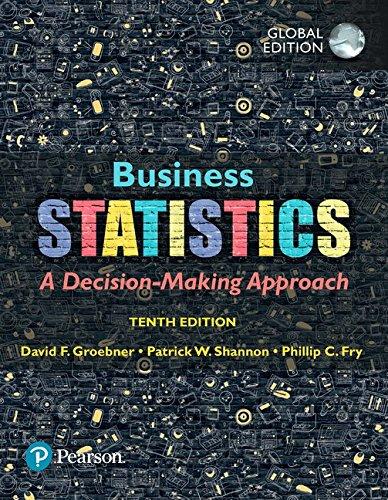The following data represent enrollment in a major at your university for the past six semesters. (Note:
Question:
The following data represent enrollment in a major at your university for the past six semesters. (Note:
Semester 1 is the oldest data; semester 6 is the most recent data.)
Semester Enrollment 1 87 2 110 3 123 4 127 5 145 6 160
a. Prepare a graph of enrollment for the six semesters.
b. Based on the graph you prepared in part
a, does it appear that a trend is present in the enrollment figures?
c. Prepare a single exponential smoothing forecast for semester 7 using an alpha value of 0.35. Assume that the initial forecast for semester 1 is 90.
d. Prepare a double exponential smoothing forecast for semester 7 using an alpha value of 0.20 and a beta value of 0.25. Assume that the initial smoothed constant value for semester 1 is 80 and the initial smoothed trend value for semester 1 is 10.
e. Calculate the MAD values for the simple exponential smoothing model and the double exponential smoothing model at the end of semester 6.
Which model appears to be doing the better job of forecasting course enrollment? Don’t include period 1 in the calculation.
16-36. The following data represent the average number of employees in outlets of a large consumer electronics retailer:
Year 2006 2007 2008 2009 2010 2011 2012 2013 2014 2015 Number 20.6 17.3 18.6 21.5 23.2 19.9 18.7 15.6 19.7 20.4
a. Construct a time-series plot of this time series. Does it appear that a linear trend exists in the time series?
b. Calculate forecasts for each of the years in the time series. Use a smoothing constant of 0.25 and single exponential smoothing.
c. Calculate the MAD value for the forecasts you generated in part b.
d. Construct a single exponential smoothing forecast for 2016. Use a smoothing constant of 0.25.
16-37. A brokerage company is interested in forecasting the number of new accounts the office will obtain next month. It has collected the following data for the past 12 months:
Month Accounts 1 19 2 20 3 21 4 25 5 26 6 24 7 24 8 21 9 27 10 30 11 24 12 30
a. Produce a time-series plot for these data. Specify the exponential forecasting model that should be used to obtain next month’s forecast.
b. Assuming a double exponential smoothing model, fit the least squares trend to the historical data, to determine the smoothed constant-process value and the smoothed trend value for period 0.
c. Produce the forecasts for periods 1 through 12 using a = 0.15, b = 0.25. Indicate the number of new accounts the company may expect to receive next month based on the forecast model.
d. Calculate the MAD for this model.
Business Applications
Step by Step Answer:

Business Statistics
ISBN: 9781292220383
10th Global Edition
Authors: David Groebner, Patrick Shannon, Phillip Fry





